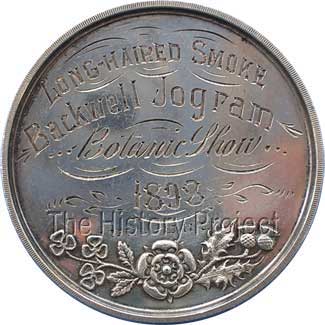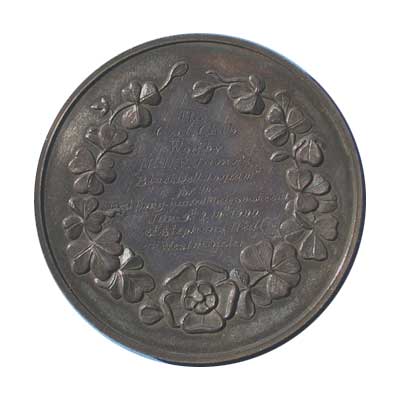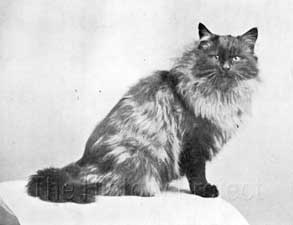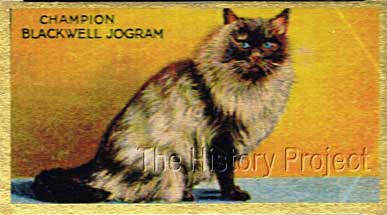 | ||||||||||||||||||||||||||









|
BACKWELL JOGRAM (1897)PHOTOS | SOCIAL MEDIA | REFERENCES
HISTORICAL BACKGROUND:It was not until 1893 that Smoke Persian cats, were finally considered sufficiently popular, to deserve a class to themselves at Shows, having formerly been relegated to the 'any other colour' class. In 1903, Frances Simpson describes the correct form of the ideal smoke as follows: "It is a shaded cat without markings, the fur being pure white underneath, and gradually assuming an almost black tone on the outer coat. The face, paws, and back, down to the tip of the tail, are the darkest parts, shading to a dark grey down the sides, and on the underpart of the tail. A very great beauty in smokes is the light frill and ear tufts, which lend an air of much distinction, to this breed. The great failings in many smokes, is the appearance of tabby markings; these especially mar the beauty of the head and face, and take away their value in the show pen. The tail should be quite free of any rims of light and dark, and should have the upper part and even dark colour, and underneath a cinder grey. "It is most important that the coat of a smoke should be long and of the true Persian flakiness, otherwise the chief beauty of the contrast between the light undercoat and the dark outer-coat is not seen to full advantage. "It is curious that when the kittens are first born, they appear almost a dead black, with no trace of a white under-coat. This appears gradually as the kittens grow, and at three weeks old the lighter coat becomes visible. Their faces and paws should be intensely black when born, as the tendency in smokes is to get lighter and not darker. "As with black kittens, so with smokes; they are often very rusty in appearance, but this will disappear with their kitten coat. This also applies to tabby markings, though, of course, if there is any tabby blood in the strain, the markings may be retained. For this reason it is most undesirable to mate smokes with tabbies; neither is it advisable to select a blue as a cross. The blue tinge destroys the purity of the white undercoat, which is one of the glories of a perfect smoke. "Perhaps the most consistent and successful breeder of smokes now in the fancy is Mrs. H.V.James, who started in 1893, and has been faithful to this breed ever since. I have had the pleasure of visiting Mrs. James's smoke cattery, and I felt that the lovely old-fashioned garden surrounding the Grange at Backwell was truly an ideal place for successfully rearing live stock of any kind, and all the pussies were pictures of robust health."1 PARENTAGE & OWNERSHIP:"Jogram is owned and was bred by Mrs. H.V.James, who is one of the most enthusiastic breeders of this handsome variety".2 'Backwell Jogram' was born on 2nd April, 1897, sired by Mrs. James's own 'Backwell Jubilee' (1893), himself bred by Mr. J. Trousdale, and out of 'Backwell Jill'(1894), who had been bred by Miss Bray. Mrs. James, gives this account of the acquisition of 'Backwell Jill', the eventual loss of 'Backwell Jubilee' and the birth and retention of 'Jogram': "At the Palace in 1894, I bought a smoke female kitten from Miss Bray as a mate for 'Jubilee'. This mating proved successful, and I had several grand litters of smokes, most of which, I am sorry to say, went to swell the ranks of neuter pets, being given as presents to my friends. In time I learnt wisdom, however, and kept my smokes myself. 'Jubilee's career as a show cat was unfortunately cut short after his Brighton win in 1894. He escaped one night, and in a fight with another cat had his ears so torn that I was unable to exhibit him again. A year later, when I was away from home, he was let out one day, and never returned, having, I expect, been trapped in the woods. At that period my smokes nearly died out, as I had only one litter a few weeks old by 'Jubilee'. Of the two smokes, one was promised, and the other I kept, and he is still alive as 'Champion Backwell Jogram'."
Unknown
Blackwell Jubilee, Black Smoke
| Unknown
Backwell Jogram,Apr-2-1897, Black Smoke M
| Tomato, Blue
Backwell Jill, Smoke
Silverina
SIBLINGS & SHOWS:As can be determined from the above statement, earlier siblings were all desexed, and Jogram's one litter mate promised to another, so that Jogram was the sole surviving cat from the original combination of 'Jubilee' and 'Jill'. Frances Simpson further tells us: "Champion Backwell Jogram was the first Smoke champion and the winner of many 1st prizes, medals and specials".2 The above claim and subsequent medal wins are evidenced by the images of Jogram's medals on this page, which are indeed most fortunate to have been preserved, in the collection of Cat Medals belonging to Missi and Christopher Eimer of London, who have generously photographed them, granting permission for us to feature them in this history of Jogram. The medals show that he was successfully exhibited at shows run by both the National Cat Club and The Cat Club, winning Best Longhaired Smoke in successive years, in 1898, 1899, and 1900. In addition, Frances Simpson informs us: "At the Crystal Palace Show, 1901, this fine Persian cat won the special offered by the Duchess of Bedford for the best Smoke male in the show".2 BREEDING & PROGENY:Mrs. James then enlightens us about her aspirations for the progression of the bloodline: "I hope, however, that for some years, at least, Jubilee's descendants will continue to flourish, as there are a number of Jogram's kittens scattered over England, and several have left these shores for America." Among his more notable progeny in England, the following females were retained for breeding by Mrs. James, these four all being from a pairing with his half-sister, 'Backwell Judy', a daughter of 'Jubilee'.
'Joyful' was later bred to another well-known smoke cat 'Teufel' owned by Mrs. Sinkin, combining both famous smoke strains to produce 'Queenie' the dam of 'Teufel II'. A smoke male, 'Bulger' bred from Jogram by Mrs. Harber, born 18th May 1900, appears in the studbook as the sire of a number of other smokes. Another litter, bred by Mrs. Langford Sainsbury by Jogram and out of Mrs. Sainsbury's unnamed 'Smoke' resulted in a male, 'Backwell Jogram II' and 'Backwell Jollygirl', both which are shown to be owned by Mrs. James. PHOTOS:
SOCIAL MEDIA :From Frances Simpson, we quote the following: "He has sired many noted winners, and is much in request as a stud cat."2 The misspelling of his name (which appears to be a regular problem, even with some of the engraved medals) shows in this 'stud' advertisement, which appears in the Cattery Advertising section of most of the 1903 issues of 'Our Cats'.
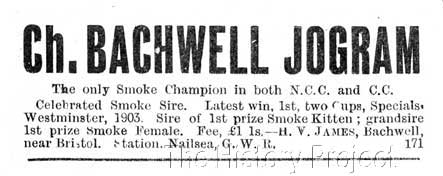
REFERENCES:
Registers associated with this article include The Incorporated Cat Fanciers Association of Great Britain (TICFAGB), National Cat Club (NCC), The Cat Club (CCR), Beresford Cat Club (BCC), Feline Federation Francaise (FFF), Siamese Cat Registry (SCR), US Register & Studbook for Cats (USR)including Supplement(USRS), The Studbook of the American Cat Association (ACA), and the Studbook & Register of the Cat Fanciers' Association (CFA).
|
|||||||||||||||||||||||||
Home | Cats | Gallery | Clubs | People | Artifacts | Articles | Updates | Contact Us ©The CFA Foundation, Inc and The Harrison Weir Collection
|
||||||||||||||||||||||||||

